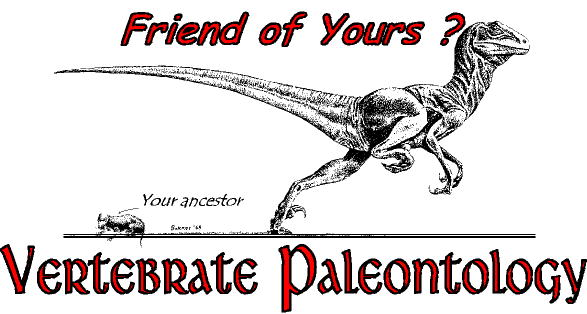
What is Vertebrate Paleontology About?
233 Miller Hall - phone 6531
Vertebrates are only one of about 3 dozen phyla of multicelled animals, and - except for the fact we are ourselves vertebrates - it seems strange to spend an entire semester on just one phylum. And, it could be argued that we are not even the most important phylum on the planet, at least as far as understanding the biogeochemical cycles by which this planet really operates (which is mostly about bacteria and protists anyway).
Nonetheless, vertebrates are large and obvious creatures we easily see around us all the time and there has always been a special focus on them. Even in the study of paleontology there has always been a tradition of a course on invertebrate paleontology (that includes everything that is not a vertebrate, so bacteria and protists also), plus one on paleobotany, and finally one on vertebrate paleontology.
continue from home page
But, of course, everyone is familiar with dinosaurs. Book shelves groan under the weight of them, and there are many paleotologists who specialize in them. And, who can deny their fascination. They are fascinating! Whole courses are devoted just to dinosaurs - and that is probably not enough time to do them justice. But, dinosaurs are found in only two orders or reptiles, and that is a very small sampling of the diversity of vertebrates. It can easily be argued that fish evolution has been richer, more complex, and more diverse than dinosaur evolution. Indeed, that fish are as sophisticated and highly evolved as any group of organisms on this planet - even if they do live in water. Even if they were the first vertebrates to evolve. Just because they were the first vertebrates does not make them primitive, and just because they never left the water does not make them less important. And, that is something a course in vertebrate paleontology should make plain. Fish may have more to tell us about evolution than dinosaurs.
But, paleontology is also about organisms that have been extinct for so long that no average person knows they exist. Of course, dinosaurs are extinct, but for all the press they get, all the times movies involve them (Jurassic Park), or something like them (Godzilla), all the cartoons they appear in - why there is even Barney the kid's show dinosaur - we almost expect to find one still living in the wild somewhere. Indeed, many people believe that dinosaurs and humans lived on the Earth at the same time (I think Barney Rubble and the Flintstones, as well as cartoons, have had a lot to do with that), even though in fact they are separated in time by nearly 60 million years.
Still, there are major groups of vertebrates with long, complex, evolutions that have not a single living member. Labrynthodont and Lepospondyl amphibians come to mind, as well as Synapsids the group ancestral to mammals.

 Ironically, Synapsids (and likely mammals for that matter) appeared and went extinct before dinosaurs appeared and were the richest, most diverse, and most abundant vertebrates on the planet for millions of years. These are facts that a course in vertebrate paleontology reveals.
Ironically, Synapsids (and likely mammals for that matter) appeared and went extinct before dinosaurs appeared and were the richest, most diverse, and most abundant vertebrates on the planet for millions of years. These are facts that a course in vertebrate paleontology reveals.Another perspective that comes from paleotology is a richer understanding of the diversity of vertebrates than we can get from biology. From a biological perspective there are fish, amphibiians, reptiles, birds, and mammals, this division being based on living vertebrates. It is not that simple. Synapsids, for example, (the stock that gave rise to mammals) is commonly referred to as the mammal-like reptiles but that is a misconception. They might be at the same grade of evolution as reptiles (although that is not certain either), but they are not reptiles, at least not as we think about modern reptiles (turtles, lizards, snakes, crocodiles). In one sense Synapsids represent another whole class of vertebrates (fish, amphibians, reptiles, synapsids, mammals, and birds). Or, from a cladistic sense (cladistics is a method of taxonomy that is now pervasive in paleotology studies) mammals are just more derived synapsids and some would argue they should not be in an order of their own. And, in the same vein birds, . . .well, recent fossil finds are demonstrating that there are many dinosaurs that are feathered so if birds are defined as having feathers then birds are just more derived dinosaurs. Or, said another way, dinosaurs are not extinct - they survive as birds.
What vertebrate paleontology give us is a perspective of over 500 million years of evolution, looking at all the beasts that have populated that history, rather than just the very last instant of vertebrate evolution with its very impoverished and unrepresentative survivors. Return to Geol/Biol 405 Vertebrate Paleontology home page